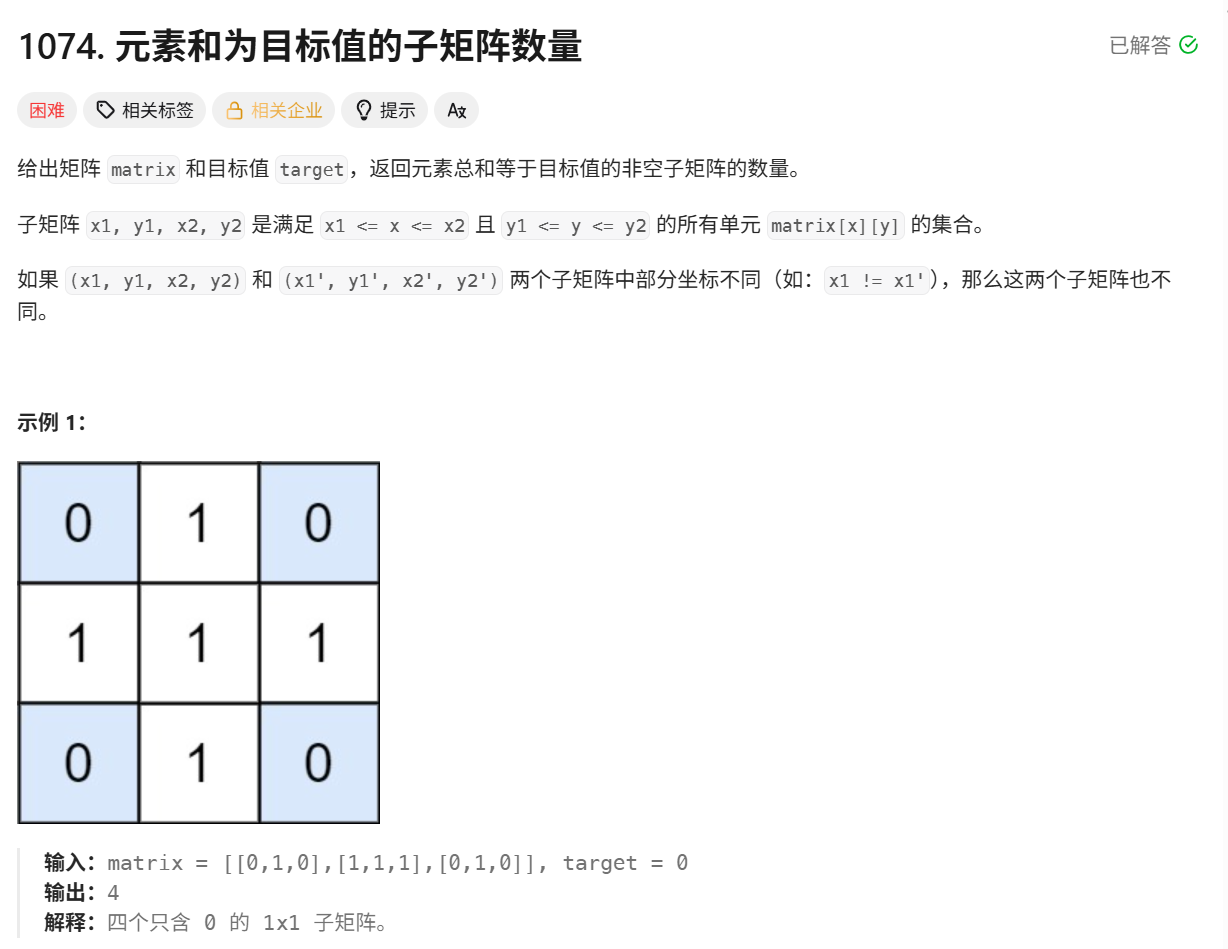LeetCode 1074:元素和为目标值的子矩阵数量

问题定义与核心挑战
给定二维矩阵 matrix 和目标值 target,需统计 所有和为 target 的非空子矩阵数量 。直接枚举所有子矩阵的时间复杂度为 O(m²n²)(m、n 为矩阵行列数),无法通过大数据用例,因此需要降维优化。
核心思路:二维转一维 + 前缀和哈希表
将二维问题转化为多个一维子问题:
- 固定上下边界 :遍历所有可能的上边界
top和下边界bottom,将两边界之间的列和压缩为一维数组colSum(colSum[col]表示top到bottom行、第col列的和)。 - 一维子数组统计 :对
colSum数组,使用前缀和 + 哈希表 的方法,统计和为target的子数组数量(时间复杂度O(n))。
算法步骤详解
步骤 1:遍历上下边界
- 枚举所有可能的上边界
top(从第 0 行到第m-1行)。 - 对每个
top,初始化colSum数组(记录列和),并枚举下边界bottom(从top到第m-1行)。
步骤 2:更新列和数组 colSum
对于当前 bottom,将 matrix[bottom][col] 累加到 colSum[col] 中,得到 top 到 bottom 行的列和。
步骤 3:统计一维子数组和为 target 的数量
对 colSum 数组,使用前缀和 + 哈希表:
- 前缀和
currentSum:记录当前遍历到第col列时的前缀和(前col+1列的和)。 - 哈希表
prefixCounts:记录前缀和出现的次数(初始时prefixCounts.put(0, 1),表示前缀和为 0 的情况,对应子数组从第 0 列开始)。 - 对于每个列和
num:- 计算
need = currentSum - target,若need存在于prefixCounts,则累加对应次数(即存在以当前列为结尾的子数组和为target)。 - 更新
currentSum并记录到prefixCounts中。
- 计算
完整代码(Java)
java
import java.util.HashMap;
import java.util.Map;
class Solution {
public int numSubmatrixSumTarget(int[][] matrix, int target) {
int m = matrix.length;
int n = matrix[0].length;
int ans = 0;
// 枚举上边界 top
for (int top = 0; top < m; top++) {
int[] colSum = new int[n]; // 记录当前上下边界之间的列和
// 枚举下边界 bottom(从 top 开始,逐步扩展)
for (int bottom = top; bottom < m; bottom++) {
// 更新列和:加上当前行 bottom 的元素
for (int col = 0; col < n; col++) {
colSum[col] += matrix[bottom][col];
}
// 统计当前 colSum 中,和为 target 的子数组数量
ans += countSubarrays(colSum, target);
}
}
return ans;
}
/**
* 统计一维数组 nums 中,和为 target 的子数组数量
* 使用前缀和 + 哈希表优化,时间复杂度 O(n)
*/
private int countSubarrays(int[] nums, int target) {
int count = 0;
int currentSum = 0;
Map<Integer, Integer> prefixCounts = new HashMap<>();
prefixCounts.put(0, 1); // 初始状态:前缀和为 0 出现 1 次(对应空数组)
for (int num : nums) {
currentSum += num;
// 寻找是否存在前缀和为 currentSum - target 的情况
int need = currentSum - target;
if (prefixCounts.containsKey(need)) {
count += prefixCounts.get(need);
}
// 更新当前前缀和的出现次数
prefixCounts.put(currentSum, prefixCounts.getOrDefault(currentSum, 0) + 1);
}
return count;
}
}复杂度分析
-
时间复杂度 :
O(m²n)。- 外层遍历上下边界:
O(m²)(m行,每行最多遍历m次)。 - 内层处理列和与一维子数组:
O(n)(每轮列和更新O(n),一维统计O(n))。
总复杂度为O(m² × n),对于m=100、n=100,计算量为100²×100=1e6,高效可行。
- 外层遍历上下边界:
-
空间复杂度 :
O(n)。colSum数组和哈希表最多占用O(n)空间(n为列数)。
示例验证
示例 1 (输入 matrix = [[0,1,0],[1,1,1],[0,1,0]], target = 0):
- 当
top=0、bottom=0时,colSum = [0,1,0],统计得 2 个 子数组([0]、[0])。 - 当
top=2、bottom=2时,colSum = [0,1,0],同样统计得 2 个 子数组。 - 总数量为
2+2=4,符合示例输出。
示例 2 (输入 matrix = [[1,-1],[-1,1]], target = 0):
- 当
top=0、bottom=1时,colSum = [0,0],统计得 3 个 子数组([0]、[0,0]、[0])。 - 结合其他边界组合,最终总数量为 5,符合示例输出。
该方法通过二维转一维 和前缀和哈希表 ,高效将复杂度从 O(m²n²) 降至 O(m²n),是处理二维子矩阵和问题的经典优化思路。